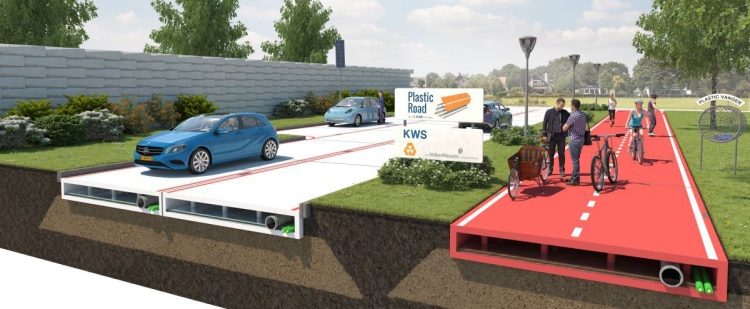For most of us, when we think of road and bridge construction it’s usually when we are being delayed by a work zone or when we resign ourselves to driving through the smaller potholes to avoid being swallowed up by the bigger potholes. When we do think about road and bridge construction, the terms “new innovations” and “cutting edge technology” probably never cross our minds.
Asphalt road construction hasn’t changed that much in the past 100+ years. Asphalt, also known as bitumen, is a semi-solid petroleum product. The black, sticky asphalt is combined with an aggregate mixture of sand and crushed rock to create asphalt cement. The mixture is heated and then spread and compacted over the prepared roadbed.
That could all be changing with just one word. That word, famously offered by Mr. McGuire (Walter Brooke) to Benjamin Braddock (Dustin Hoffman) in the film The Graduate, is plastics.
Plastic Roads
KWS Infra, a division of VolkerWessels, developed the concept of PlasticRoad, modular road sections made of recycled plastic and last year. Still in the conceptual stage, the modular sections, made of 100% recycled material like polyethylene and polypropylene, would be manufactured in a factory and then transported and assembled onsite.
Because the PlasticRoad segments would be lighter than traditional asphalt, they believe the roadbed will be less susceptible to subsidence, gradual caving or sinking, which leads to potholes. When the roads reach the end of their lifecycle, they can be recycled again, diverting waste from ending up in landfills.
VolkerWessels claims that their PlasticRoad technology can be installed in a fraction of the time it takes to build a road using traditional asphalt. They also state that this new road surface will last two to three times longer than asphalt, require less maintenance and have to ability to withstand temperatures ranging from -40° to 176° Fahrenheit.
The lightweight road sections would feature a hollow core that could be used to run electrical and telecommunication cables, sewer and water pipes and drainage.
That might prove problematic when it comes time to make repairs or replace a broken pipe for instance since it appears the whole section of road would have to be removed. A smarter option might be to build raceways alongside the shoulder of the plastic road with access points for repairs or new installation.
KWS Infra recently signed an agreement with Wavin, a Dutch plastic pipe manufacturer, and Total S.A., a petrochemical firm, to develop the PlasticRoad. They plan to have a prototype completed by the end of 2017.
Of course, recycling plastic waste into roads isn’t an entirely new concept. Plastic has been used as a partial substitute for bitumen in some road projects in India for over a decade. The process involves melting shredded waste plastic and mixing it with hot aggregate to get plastic coated aggregate which is then mixed with bitumen to pave roads.
This is similar to polymer modified asphalt, except that instead of creating new polymers for the road construction, they are using waste plastics from shopping bags and food packaging. India has a growing garbage problem and the Indian government made the use of plastic waste mandatory in road construction back in November 2015.
Plastic Bridges
The technology for thermoplastic composite bridges was developed in the late 1980s at Rutgers University as part of a government-funded program to develop recycling systems for plastics. The composite polymer used to make the bridge components are 80 percent post-consumer high-density polyethylene (HDPE), think milk jugs and shampoo bottles, and 20 percent polystyrene plastics which are recycled from old automotive bumpers and dashboards. The bridge materials are manufactured by AXION International and developed in conjunction with Rutgers University.
Currently, there are only two bridges located on public roads in the United States that are made of 100 percent recycled plastics. The first was completed in December 2011 on Birch Hill Road in York, Maine. The second, with a span of 24.6-ft, is the longest in the United States and located on Township Road 174 in Logan County, Ohio.
This bridge was opened to the public in December 2012 and was 80 percent funded by the Innovative Bridge Research and Deployment Program which is a federal program developed “to promote, demonstrate, evaluate, and document the application of innovative designs, materials, and construction methods in the construction, repair, and rehabilitation of bridges and other highway structures.”
The longest recycled plastic bridge is located in Peeblesshire, Scotland on private land spanning the River Tweed was made of 50 tons of recycled plastic. The bridge is 90-ft long and built to support up to 44 metric tons.
Other examples of thermoplastic composite bridges include ones at Fort Bragg, North Carolina that were designed to bear the weight of a 71-ton M1 Abrams tank as well as two railroad bridges located at Fort Eustis in Virginia. The railroad bridges at Fort Eustis, one is 38.5-ft long and the other is 80-ft long, are engineered to support 130 tons.
Thermoplastic composite bridges boast a number of advantages over bridges made of steel, timber and concrete. The composite polymer the bridges are made out of won’t rot, rust or crack due to the elements and is an eco-friendlier option over traditional bridge building materials.
Unlike a timber bridge, it won’t absorb moisture and is immune from insect infestations. These bridges require very little maintenance and have a life expectancy of over 50 years at which time they can be dismantled and recycled for some other purpose. In addition to being a part of the solution to one component of the nation’s failing infrastructure, it would also eliminate thousands of tons of plastic waste that might otherwise end up in a landfill.
